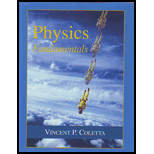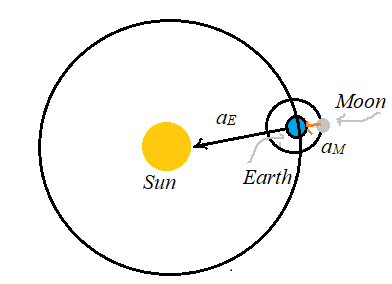
Concept explainers
(a)
The magnitudes of the velocity and acceleration of the Moon relative to the Earth.
(a)
Answer to Problem 40P
The velocity of the Moon as it travels in a circular orbit around the Earth is found to be
Explanation of Solution
Given:
The radius of the Moon’s orbit around the Earth,
The time period of revolution of the moon around the Earth,
Formula used:
The Moon travels a distance equal to the circumference of its orbit in the time equal to its time period. Its velocity
As it revolves around the Earth, it experiences a
Calculation:
Express the radius of the Moon’s orbit around the Earth in meters.
Express the time period of the Moon’s revolution around the Earth.
Substitute the values of
Substitute the values of
Conclusion:
Thus, the velocity of the Moon as it travels in a circular orbit around the Earth is found to be
(b)
The magnitudes of the velocity and acceleration of the Earth relative to the Sun
(b)
Answer to Problem 40P
The velocity of the Earth as it travels in a circular orbit around the sun is found to be
Explanation of Solution
Given:
The radius of the Earth’s orbit around the Sun,
The time period of revolution of the Earth around the Sun,
Formula used:
The Earth travels a distance equal to the circumference of its orbit in the time equal to its time period. Its velocity
As it revolves around the Sun, it experiences a centripetal force towards the center of its orbit. Its centripetal acceleration is given by,
Calculation:
Express the radius of the Earth’s orbit around the sun in meters.
Express the time period of the Earth’s revolution around the Sun.
Substitute the values of
Substitute the values of
Conclusion:
Thus, velocity of the Earth as it travels in a circular orbit around the sun is found to be
(c)
The value of the maximum acceleration of the Moon relative to Sun and the phase of the Moon this occurs.
(c)
Answer to Problem 40P
The value of the maximum acceleration of the Moon relative to Sun is found to be
Explanation of Solution
Given:
The acceleration of the Moon relative to Earth,
The acceleration of the Earth relative to the Sun,
The radius of the Earth’s orbit around the Sun,
The radius of the Moon’s orbit around the Earth,
Calculation:
The Moon revolves around the Earth in a circular orbit and the Earth revolves around the Sun. The Moon experiences accelerations relative to both Earth and the sun.
This is shown in the diagram below:

At New Moon day, the moon is farthest from the Sun and its acceleration towards the Earth and that towards the Sun point in the same direction. Hence, at this time, the accelerations add up and the Moon’s acceleration relative to the Sun is maximum.
Calculate the distance of the moon from the Sun when it is at its farthest position from the Sun.
The Moon’s distance from the Sun is nearly equal to the Earth’s distance from the Sun.
The Moon experiences an acceleration directed towards the Earth due its revolution around the Earth and since it moves around the Sun along with the Earth, it experiences an acceleration towards the Sun. During New moon day, the Moon, Earth and the Sun are in a straight line with the Moon at the farthest from the Sun. In this position, the acceleration of the Moon towards the Earth and towards the Sun are directed along the same straight line, towards the Sun. Hence, they add up.
Since the distance of the Moon from the Sun is nearly equal to that of the Earth’s distance from it, the Moon’s acceleration due its revolution around the Sun can be taken to be equal to that of the Earth’s around the Sun.
The Moon’s maximum acceleration in a direction towards the Sun
Substitute the values of the accelerations in the above expression.
Conclusion:
Thus, the value of the maximum acceleration of the Moon relative to Sun is found to be
Want to see more full solutions like this?
Chapter 3 Solutions
Physics Fundamentals
- A particle is moving around in a circle and its position is given in polar coordinates as x = Rcosθ, and y = Rsinθ, where R is the radius of the circle, and θ is in radians. From these equations derive the equation for centripetal acceleration.arrow_forwardAssume that the earth’s orbit around the sun is circular and has a radius. (a) What is the magnitude of the orbital velocity of the earth, in meters per second (b) What is the magnitude of the centripetal acceleration of the earth toward the sun, in meters per second squared?arrow_forward(b) An Earth satellite moves in a circular orbit 640 km above Earth's surface with a period of 98.0 min. What are the (a) speed and (b) magnitude of the centripetal acceleration of the satellite? (4)arrow_forward
- Initially, an object in uniform circular motion (assume clockwise motion) has a velocity vector given by v = (-3.00") î + (4.00"). If the radius of travel is 3.00 meters, determine the acceleration vector (in unit-vector notation) after 5.00 seconds have elapsed.arrow_forwardA merry-go-round with radius 1.2 m is moving in a circular motion with 6 m/s. Compute its(a) period of the motion. (b) centripetal acceleration.arrow_forwardA car initially traveling eastward turns north by traveling in a circular path at a uniform speed. The length of the arc ABC is 210 m, and the car completes the turn in 38.0 s. (a) What is the acceleration when the car is at B located at an angle of 35.0 degrees? (b) Determine the car's average speed. (c) Determine its average acceleration during the 38.0 s interval.arrow_forward
- If the speed of an object in uniform circular motion is tripled and the radial distance remains constant, then the magnitude of the centripital acceleration increases by what factor?arrow_forwardwhat value of speed must be given to a projectile so asto launch it from earth's surface at a height (h) equal to (1/4) of the radius of the earth?arrow_forwardA car initially traveling eastward turns north by traveling in a circular path at uniform speed as shown in above figure. The length of the arc ABC is 235m, and the car completes the turn in 36.0s. (a) What is the acceleration when the car is at B located at an angle of 35.08? Express your answer in terms of the unit vectors i^ and j . Determine (b) the cars average speed and (c) its average acceleration during the 36.0s interval.arrow_forward
- Suppose a projectile is fired from a cannon with velocity vo and angle of elevation 0. The horizontal distance R (0) it travels (in feet) is given by the following. (Vo) sin 20 R (0) 32 = 160 ft/s, what angle 0 (in radians) should be used to hit a target on the ground 519 feet in front of the cannon? If Vo Do not round any intermediate computations, and round your answer(s) to the nearest hundredth of a radian. (If there is more than one answer, enter additional answers with the "or" button.) e = rad O or Oarrow_forwardIf a rock is thrown vertically upward from the surface of Mars with velocity of 15 m/s, its height (in meters) after t secer is h= 15t-1.86². (a) What is the velocity (in m/s) of the rock after 3 s? 3.84 m/s (b) What is the velocity (in m/s) of the rock when its height is 10 m on its way up? On its way down? (Round your answers to two decimal places.) up 22.2 x m/s down -22.2 x m/s Need Help? Submit Answer Read Itarrow_forwardAn Earth satellite moves in a circular orbit 940 km above Earth's surface with a period of 103.6 min, What are (a) the speed and (b) the magnitude of the centripetal acceleration of the satellite?arrow_forward
 College PhysicsPhysicsISBN:9781305952300Author:Raymond A. Serway, Chris VuillePublisher:Cengage Learning
College PhysicsPhysicsISBN:9781305952300Author:Raymond A. Serway, Chris VuillePublisher:Cengage Learning University Physics (14th Edition)PhysicsISBN:9780133969290Author:Hugh D. Young, Roger A. FreedmanPublisher:PEARSON
University Physics (14th Edition)PhysicsISBN:9780133969290Author:Hugh D. Young, Roger A. FreedmanPublisher:PEARSON Introduction To Quantum MechanicsPhysicsISBN:9781107189638Author:Griffiths, David J., Schroeter, Darrell F.Publisher:Cambridge University Press
Introduction To Quantum MechanicsPhysicsISBN:9781107189638Author:Griffiths, David J., Schroeter, Darrell F.Publisher:Cambridge University Press Physics for Scientists and EngineersPhysicsISBN:9781337553278Author:Raymond A. Serway, John W. JewettPublisher:Cengage Learning
Physics for Scientists and EngineersPhysicsISBN:9781337553278Author:Raymond A. Serway, John W. JewettPublisher:Cengage Learning Lecture- Tutorials for Introductory AstronomyPhysicsISBN:9780321820464Author:Edward E. Prather, Tim P. Slater, Jeff P. Adams, Gina BrissendenPublisher:Addison-Wesley
Lecture- Tutorials for Introductory AstronomyPhysicsISBN:9780321820464Author:Edward E. Prather, Tim P. Slater, Jeff P. Adams, Gina BrissendenPublisher:Addison-Wesley College Physics: A Strategic Approach (4th Editio...PhysicsISBN:9780134609034Author:Randall D. Knight (Professor Emeritus), Brian Jones, Stuart FieldPublisher:PEARSON
College Physics: A Strategic Approach (4th Editio...PhysicsISBN:9780134609034Author:Randall D. Knight (Professor Emeritus), Brian Jones, Stuart FieldPublisher:PEARSON





